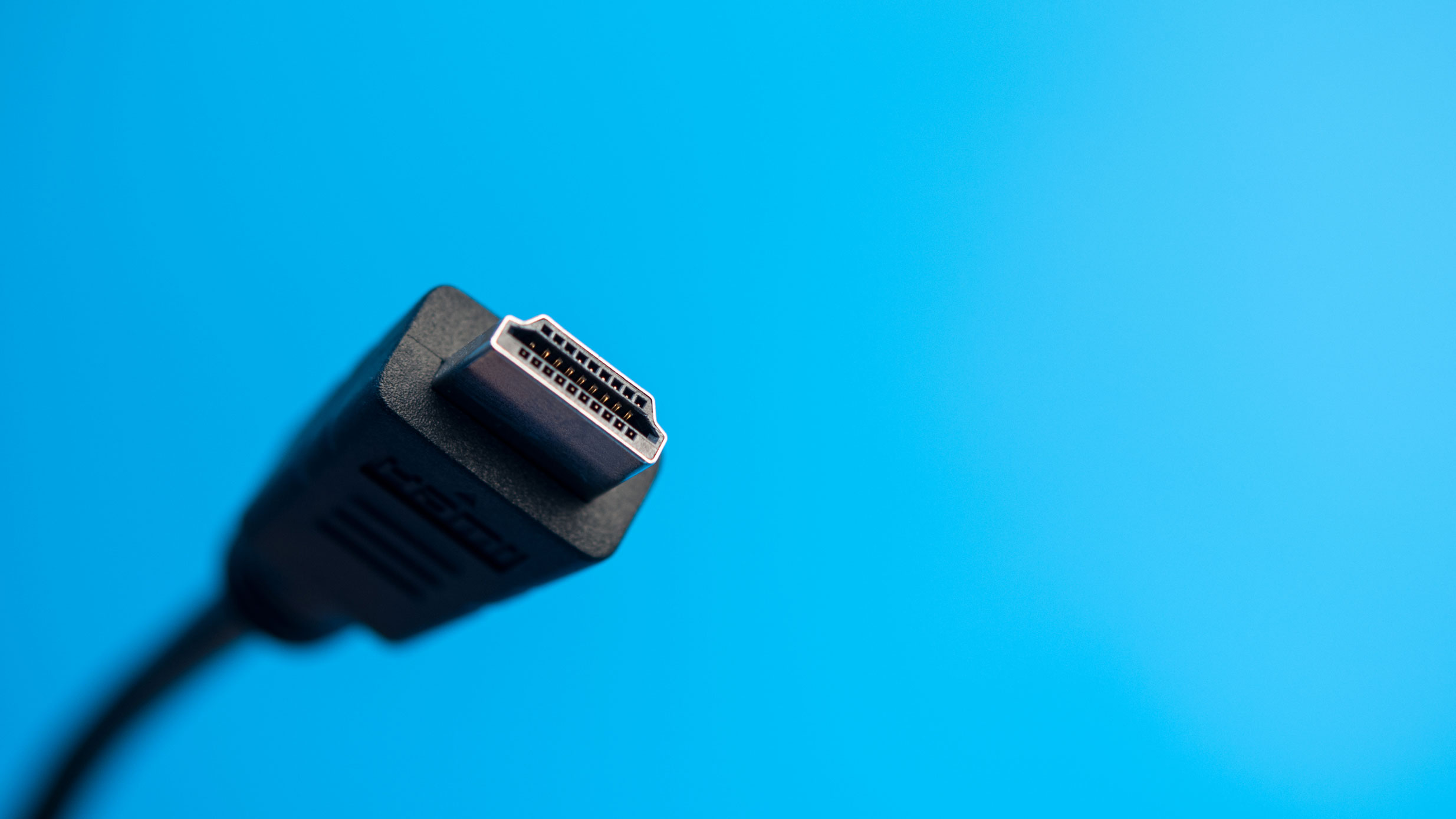HDMI vs DVI cables: A no-nonsense guide
When it comes to HDMI vs DVI cables, which should you get? Our guide reveals all.

Although the term DVI isn’t probably one that you’ve heard for a while, it’s important to know the difference between HDMI and DVI cables when you’re looking at the best system for video editing, gaming or productivity. Many of the best monitors for video editing, graphic design and photography, for example, still offer multiple connectivity options, including DVI. With several peripherals littering our desks, all of which need to be hooked up somehow, it’s important to know how this should it be done to achieve optimum results. Often, that comes down to a simple question: do you need an HDMI or DVI cable?
To the untrained eye, it can be a minefield of resolutions, data rates and supported features. The best laptops for graphic design, for example, often don’t offer DVI connectivity anymore as frankly it’s an outmoded option, but if you have one of the best monitors for graphic design or creativity, you’re able to plug in a DVI cable with a simple adaptor. We’ll look at the topic in a bit more detail in this article, and assess whether DVI, as an industry standard connectivity option in the 1990s and 2000s, is still an option you need to have in your arsenal.
The answer depends on more than just the ports on your best laptop for video editing. But fear not, our no-nonsense guide lays out exactly why you might need each cable, and which is the best option for creatives right now.
Footprint

There’s a large difference in size between HDMI and DVI.
Being the older standard, it’s perhaps unsurprising that DVI is the larger of the two. A typical DVI plug is rectangular in shape, with 24 pins three rows deep making up the bulk of its front side. To the right of this matrix is a square consisting of four more pins. The whole arrangement is flanked on either side by screws that fix it in place. The number of pins, combined with the screws, make DVI a relatively large plug and unlike HDMI, DVI cables can be quite easy to damage. If you bend the pins, plugging them in can be quite a challenge – definitely up there with one of the more frustrating elements of outdated computer hardware.
HDMI is much smaller than DVI and throughout the course of the mid 2000s became the standard for audio and video connectivity. The plug is a slim rectangle with a sloped lip below it and in the middle is a thin gap surrounded by 19 pins. Despite having close to the same number of pins as DVI, HDMI plugs are much more compact, and much easier to plug in largely thanks to the pins being protected and the lack of securing screws, which can get annoying if the rear of your system is hidden against the wall or an obstacle.
To put a spanner in the works, it is possible to get Mini and Micro versions of both DVI and HDMI plugs, and these are generally found on older Apple computers such as the original MacBook Air and 2009 Mac mini. Mini-HDMI and Micro-HDMI can be found on a wider variety of devices, including some tablets and phones, but are still uncommon compared to standard HDMI plugs.
Compatibility

There’s a simple solution you can purchase if you need to connect HDMI and DVI devices together. Adaptors generally work well and are very affordable to get hold of.
One of the most important questions when it comes to deciding between HDMI and DVI is what each standard works with and whether it’ll work with your devices. Check the ports on your hardware as many pieces of hardware, including some older Nvidia and AMD graphics cards, have ports for both but your TV or monitor may only support one or the other. If your monitor is an older model, it will have both options, and any screen from the early to mid 2000s may only feature a DVI, so it’s worth checking what hardware you already have and its requirements if you’re on an older setup but would like to upgrade.
HDMI is much more common than DVI and that’s been the case for the best part of the last two decades, so it’s unlikely you own a screen that doesn’t support it. When it comes to laptops, HDMI’s smaller connector is much more likely to make an appearance due to its space-saving design. You’re also likely to find it on larger computers, TVs, monitors, games consoles and a variety of other hardware types. It’s worth saying however that we’re entering a new generation of connectivity now – where HDMI replaced DVI, we’re now seeing DisplayPort and USB-C eating into HDMI’s market share. Luckily, no matter what hardware you have, adaptors are relatively easy to come by.
Quality

HDMI plugs are far more compact than their DVI equivalents, allowing them to be used in smaller devices, but both DVI and HDMI have certain limitations on what they can display both in terms of an output device’s resolution and its refresh rate. Given that HDMI is newer than DVI, it’s unsurprising that it works with better specifications in both cases.
The latest version of HDMI (2.1b) can support a maximum data rate of 48 Gbit/sec and video resolutions up to 10K, which is far more than most people will need. In terms of refresh rate, HDMI can support up to 4K at 144 Hz natively, or a mind-boggling 8K at 60 Hz natively or 120Hz if using Display Stream Compression. It also works with HDR video output (although its maximum resolutions and refresh rates take a slight hit given the increased bandwidth used by HDR video).
DVI only has a maximum data rate of 9.9 Gbit/sec, so taking that into account, the maximum resolution and refresh rate it can support is 3840x2400 at 30 Hz, or 2560x1600 at 60 Hz. It’s likely that if you own an DVI compatible monitor, you’re running on HD at 1920x1080 or less due to the available technology at the time, and with DVI, you’re also likely suffer from a difference in colour rendition as DVI only supports 8-bit RGB colours, whereas you’ll get 12-bit performance in HDMI, so more colours can be rendered natively.
As well as its visual advantages, HDMI can also transfer audio signals, something DVI is unable to do. That means streaming a video from one device to another only requires one cable with HDMI; with DVI, you also need to account for audio cables and associated sockets.
Price
Regardless of whether you need an HDMI or DVI cable, neither is likely to set you back very much. For example, you can pick up an HDMI cable on Amazon for around $5/£5, or DVI cable for around $7/£7. There are also plenty of adaptors on offer for around the same amount of money that can convert your video signal from DVI to HDMI and vice-versa, meaning outdated monitors can still be used no matter your setup.
It’s worth noting that you may sometimes see expensive versions of each cable doing the rounds, with fancy-sounding features and eye-watering price tags. Even the cheapest HDMI or DVI cable will get your signal to its destination just as fast as the most expensive one, without leaving a galling dent in your finances.
Which should you buy?
Of course this will very much depend on the system and the screens you are using in your setup, but one simple fact can’t be escaped: DVI is an entirely outmoded connectivity option these days and you’ll achieve better results overall from upgrading your setup to factor in more options like HDMI and USB-C.
If you’re looking at motherboards and must choose between one that supports HDMI and one that supports DVI, we’d advise HDMI every time. HDMI is a more modern standard and supports much higher resolutions and refresh rates, and will also work with a wider variety of peripheral devices. To future-proof your setup, we’d recommend a motherboard that hosts the option for USB-C as well as HDMI.
If you have a DVI device that you need to hook up to another device, you can always use an HDMI to DVI cable or an adapter; neither is likely to cost you much more than a fiver. Given that HDMI cables are more modern, more common and often cheaper than their DVI equivalents, there’s no real reason to stick to DVI unless your equipment dictates, but even then we’d recommend looking at some of our guides to help you upgrade to a more modern system.

Thank you for reading 5 articles this month* Join now for unlimited access
Enjoy your first month for just £1 / $1 / €1
*Read 5 free articles per month without a subscription

Join now for unlimited access
Try first month for just £1 / $1 / €1
Get the Creative Bloq Newsletter
Daily design news, reviews, how-tos and more, as picked by the editors.

Alex Blake is a freelance tech journalist who writes for Creative Bloq, TechRadar, Digital Trends, and others. Before going freelance he was commissioning editor at MacFormat magazine, focusing on the world of Apple products. His interests include web design, typography, and video games.
You must confirm your public display name before commenting
Please logout and then login again, you will then be prompted to enter your display name.
